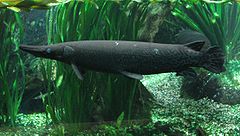Alligator Gar
Facts
Also known as: Gator Gar
Conservation Status: Unknown
Location: Fresh water in North America
Lifespan: Males - around 26 years. Females - around 50 years
Also known as: Gator Gar
Conservation Status: Unknown
Location: Fresh water in North America
Lifespan: Males - around 26 years. Females - around 50 years
Scientific Classification
Kingdom: Animalia
Phylum: Chordata
Class: Actinopterygii
Order: Lepisosteiformes
Family: Lepisosteidae
Genus: Atractosteus
Species: A. spatula
Binomial name: Atractosteus spatula
Kingdom: Animalia
Phylum: Chordata
Class: Actinopterygii
Order: Lepisosteiformes
Family: Lepisosteidae
Genus: Atractosteus
Species: A. spatula
Binomial name: Atractosteus spatula
Description
Length: 8 to 10 ft (2.4 to 3 m)
Weight: Atleast 200 lb (91 kg)
Other: the mature Alligator Gar possesses a dual row of large teeth in the upper jaw. Its name derives from the alligator-like appearance of these teeth along with the fish's elongated snout. The dorsal surface of the Alligator Gar is a brown or olive-color, while the ventral surface tends to be lighter. Their scales are diamond-shaped and interlocking (ganoid) and are sometimes used by Native Americans for jewelry and arrow heads.
Length: 8 to 10 ft (2.4 to 3 m)
Weight: Atleast 200 lb (91 kg)
Other: the mature Alligator Gar possesses a dual row of large teeth in the upper jaw. Its name derives from the alligator-like appearance of these teeth along with the fish's elongated snout. The dorsal surface of the Alligator Gar is a brown or olive-color, while the ventral surface tends to be lighter. Their scales are diamond-shaped and interlocking (ganoid) and are sometimes used by Native Americans for jewelry and arrow heads.
Behaviour
The Alligator Gar is a relatively passive, solitary fish that lives in fresh and brackish water bodies in the southeastern U.S.
The Alligator Gar is a relatively passive, solitary fish that lives in fresh and brackish water bodies in the southeastern U.S.
Predators or Prey?
Adult gars have few natural predators, although alligators have been known to attack them. Young are preyed upon by larger fish. Alligator gars prey on fish, but they are opportunistic and have been known to feed on everything from waterfowl and small turtles to carrion.
Adult gars have few natural predators, although alligators have been known to attack them. Young are preyed upon by larger fish. Alligator gars prey on fish, but they are opportunistic and have been known to feed on everything from waterfowl and small turtles to carrion.
Diet
The Alligator Gar is carnivorous and feeds by lurking amongst reeds and other vegetation, ambushing prey. Alligator gar have often been suspected in attacks on humans, but none of these attacks have been officially confirmed to be the work of this species. The Alligator gar is a carnivorous animal and fish is its staple diet. It will however also consider crustaceans and waterfowl suitable prey, and Alligator gars have been spotted when they have attacked and consumed alligators that have been up to five feet in length. The Alligator gar is aggressive and lives and hunts alone. It will usually stay hidden among underwater plants.
The Alligator Gar is carnivorous and feeds by lurking amongst reeds and other vegetation, ambushing prey. Alligator gar have often been suspected in attacks on humans, but none of these attacks have been officially confirmed to be the work of this species. The Alligator gar is a carnivorous animal and fish is its staple diet. It will however also consider crustaceans and waterfowl suitable prey, and Alligator gars have been spotted when they have attacked and consumed alligators that have been up to five feet in length. The Alligator gar is aggressive and lives and hunts alone. It will usually stay hidden among underwater plants.
Habitat
Though the Alligator Gar prefers slow-moving waters of rivers, bayous, and oxbows throughout most of the year, it appears to need spring time inundated floodplain fields or wetland vegetation in order to spawn.
Though the Alligator Gar prefers slow-moving waters of rivers, bayous, and oxbows throughout most of the year, it appears to need spring time inundated floodplain fields or wetland vegetation in order to spawn.
Conservation
Unfortunately for the alligator gar, flood-control measures such as dams and dikes have dramatically altered their riverine ecosystems and largely eliminated their preferred spawning habitats across North America. These breeding challenges have contributed to significant population declines across much of the animal's range. Alligator gars are also targeted by both commercial and sport fisheries and have frequently been overfished. They are now protected by law in parts of their range.
Unfortunately for the alligator gar, flood-control measures such as dams and dikes have dramatically altered their riverine ecosystems and largely eliminated their preferred spawning habitats across North America. These breeding challenges have contributed to significant population declines across much of the animal's range. Alligator gars are also targeted by both commercial and sport fisheries and have frequently been overfished. They are now protected by law in parts of their range.
Reproduction
Studies indicate that the Alligator gar might prefer running waters for breeding purposes and therefore leave more sluggish pools to find such environments. Spawning takes place in May and the Alligator gar deposit its eggs in shallow water.
Studies indicate that the Alligator gar might prefer running waters for breeding purposes and therefore leave more sluggish pools to find such environments. Spawning takes place in May and the Alligator gar deposit its eggs in shallow water.

